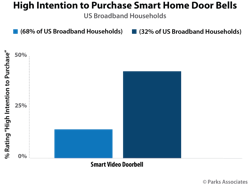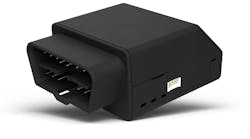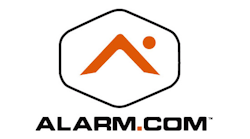The Smart Money: Home Security Expands to AI and Video Analytics
This article originally appeared in the September 2021 issue of Security Business magazine. When sharing, don’t forget to mention Security Business magazine on LinkedIn and @SecBusinessMag on Twitter.
The market for connected devices is growing, and the smart home is getting more sophisticated. As of Q4 2020, 34% of U.S. broadband households owned at least one core smart home device, 23% owned three or more, and 15% owned six or more.
Products with video and audio capabilities lead the charge, with 12-13% adoption rates for networked cameras and video doorbells. In aggregation, Parks Associates estimates more than 250 million products in three categories – networked cameras, video doorbells, and smart speakers/smart displays – will have sold in the United States between 2022 and 2024, forming an even more substantial installed base for analytical learning and innovation.
Historically, safety and security use cases drive camera and video doorbell purchases. Legacy brands tend to win with solid consideration intent and purchase results. For locks and cameras, the most often considered brand was also the most purchased. Security did well in these two categories while contending with startups and giants. Parks Associates research shows that security and surveillance benefits were mentioned by half or nearly half of respondents who acquired video devices, and the events of 2020 served to emphasize their importance.
The uncertainty caused by COVID-19 and concurrent social unrest in the United States heightened consumer anxiety about their safety and security and their families and homes. At the end of 2020, 27% of broadband households strongly agreed with the statement, “I am far more concerned about the physical security of my home than I was five years ago” – and that number rises to 43% among households with children.
Additionally, about one-third of network camera owners report relying on their devices more heavily due to the COVID-19 crisis. Consumers are increasingly turning to networked cameras and video doorbells to provide the sense of security and peace of mind traditionally provided by fully-fledged security systems.
Video and audio analytics are evolving and impacting the smart home user experience. Innovation in video and audio analytics drives new applications and services like facial, emotion, gender, situational, and object recognition, creating dramatic new capabilities to understand context and deliver value through advanced insights and improved user experience.
Traditionally, security devices recorded audio and video continuously and without analysis. A human might monitor the content in real-time or analyze particular content of interest after the fact. Still, there is less need for storage-intensive and labor-heavy implementations with the advent of video and audio analytics.
Video and audio gathered near access points is the most prominent and traditional monitoring activity, but consumers increasingly desire more monitoring beyond the entrance/exits of homes. Parks Associates research indicates that consumers are raising their expectations. Video and audio analysis of the “smart home” as defined by what is in and immediately surrounding the four walls of a house must now include distinctions among visitors and monitoring of the home's surrounding area.
Parks Associates research in Q2 2020 reveals that car security is the next leading concern after concern for the physical home and safety of loved ones, and 43% of network camera owners say they are monitoring their driveways with their devices. Protective actions for human residents can extend to vehicular ones: monitoring criminals, alerting the family and first responders. Because these devices are oriented outward, the benefits of video analytics to monitor property and loved ones come with more minor concerns about privacy. Vivint’s Car Guard and Alarm.com’s Connected Car are examples of add-on products and services that allow users to monitor automobiles.
Contextual Awareness and Event-Based Recording
Smart cameras and audio devices now monitor data and create clips after notable events. At their best, the devices perform this while using little power or storage space. For example, instead of a doorbell camera continuously recording, it can detect a delivery man moving into its field of view, recognize this as an important event, start recording and send the resulting clip of the delivery to the user. Users can then review and take action, such as asking a neighbor to collect the package or make a plan to head home.
With more complex AI and device ecosystems, the devices themselves will take action based on the events. Ring’s Smart Responses feature uses Alexa to give the video doorbell the ability to answer the door on behalf of the owner. It also takes messages and gives specific instructions to guests at the door. Users can configure quick replies from six presets, and the feature can also let people at the door know that they are being recorded. Google’s new Nest security cameras, for example, can tell the difference between a person, animal and a vehicle and generates “intelligent” alerts that avoid annoying, non-critical notifications.
As consumer need for peace of mind contributes to an increase in demand for smart products with video and audio capabilities, device makers will need to make smart choices for approaches so their devices can keep up and their companies can capitalize on the opportunities.
The Parks Associates report, Smart Home: Consumer Purchases and Preferences takes a closer look at smart product adoption and purchase intention across multiple product categories, segmentation profiles, purchase channels, and installation preferences, voice and control platforms, app engagement, reliability, and satisfaction scores by category, product feature interests, and attitudes about data security, interoperability and support.
Mark Vena is Senior Director of Smart Home and Strategy for Parks Associates. For more information on Parks Associates research, visit www.parksassociates.com.






